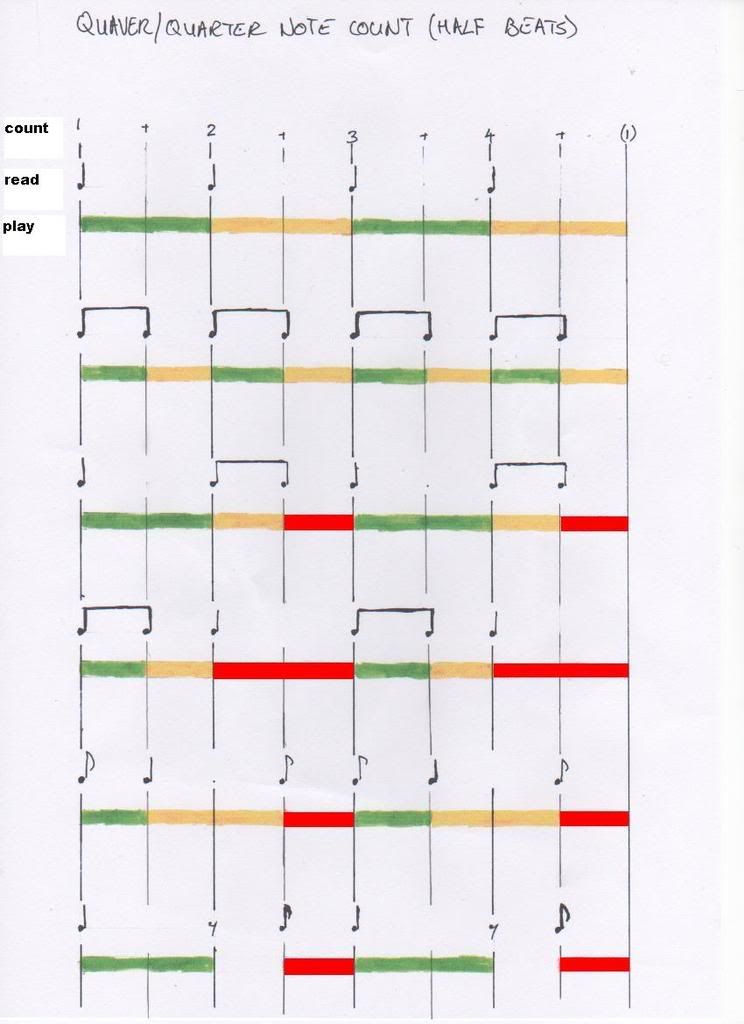Well I started today and did better than everyone else so I guess I'm doin' alright. I meant the line that was connecting the notes though. Like the thick lines between the notes. I don't really understand the difference between two and one.
Ah...note values.
Those lines are called 'beams'.
1 beam = 8th notes (half a beat, = an 8th of a bar in 4/4) - count 1 + 2 + 3 + 4 +
2 beams = 16th notes (quarter beat, = 16th of a bar in 4/4) - count 1 e + a 2 e + a 3 e + a 4 e + a
3 beams = 32nd notes (8th of a beat, = 32nd of a bar in 4/4), you will rarely see them.
So each line (beam) means the note is halved in length.
I will definitely send you some stuff to help explain, just can't access materials I need right now, will do it in the next coupla days
Those lines are called 'beams'.
1 beam = 8th notes (half a beat, = an 8th of a bar in 4/4) - count 1 + 2 + 3 + 4 +
2 beams = 16th notes (quarter beat, = 16th of a bar in 4/4) - count 1 e + a 2 e + a 3 e + a 4 e + a
3 beams = 32nd notes (8th of a beat, = 32nd of a bar in 4/4), you will rarely see them.
So each line (beam) means the note is halved in length.
I will definitely send you some stuff to help explain, just can't access materials I need right now, will do it in the next coupla days
Well what if it's like the first part is one beam then it goes into two beams? Like let me find an example in my music.MrAnderson wrote:
Ah...note values.
Those lines are called 'beams'.
1 beam = 8th notes (half a beat, = an 8th of a bar in 4/4) - count 1 + 2 + 3 + 4 +
2 beams = 16th notes (quarter beat, = 16th of a bar in 4/4) - count 1 e + a 2 e + a 3 e + a 4 e + a
3 beams = 32nd notes (8th of a beat, = 32nd of a bar in 4/4), you will rarely see them.
So each line (beam) means the note is halved in length.
I will definitely send you some stuff to help explain, just can't access materials I need right now, will do it in the next coupla days
Like the 2nd page and the first note on the bass line.
Last edited by ThaReaper (2008-05-05 18:46:58)
These sheets show how the beats are divided, and the different counting methods used (the beat always remains the same).
The colours aren't important, they are used to show the duration of each note...each time the colour changes, you play the next note.
They didn't scan too well but hope they are helpful
I will stick some further stuff up soon.
Also try the exercise at the bottom now that you have a bit more understanding...



The colours aren't important, they are used to show the duration of each note...each time the colour changes, you play the next note.
They didn't scan too well but hope they are helpful
I will stick some further stuff up soon.
Also try the exercise at the bottom now that you have a bit more understanding...



MrAnderson wrote:
Ok. I hope I can explain this over a forum...
First thing you need to do is 'hear' what you are going to play...start counting (1 e + a etc...out loud is good).
Now follow the notes as you count, so you are reading the music but not playing yet.
I don't know how good your reading is, so I will send you a couple of sheets to help, but next stage is...
Follow the music again, while still counting, and emphasize the count each time a note needs to be played, ie say it louder.
Bar 9...the stars are the 'notes'. Break it down into individual beats if necessary.
1 e + a 2 e + a 3 e + a
* * * * * * * *
Count the rests quieter if possible.
Now you can 'hear' it, and hopefully repeat it out loud without looking at the music.
Try adding the physical part; tap your leg as if you were hitting the drum. When you are sure you got it, try tapping it a few times in a row.
Finally try playing the bar on the drum.
Repeat this process for each tricky bar. It will become much faster as you do it more and more.
Also the sheets I send you should help you read alot quicker.
Hope this helps